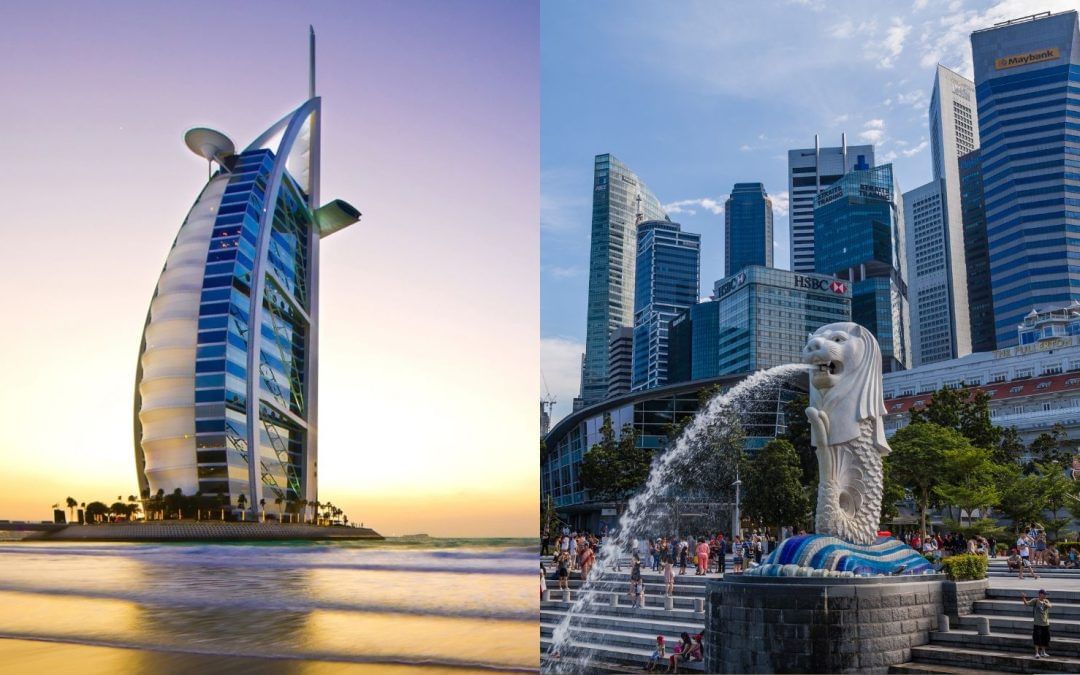Are you considering studying abroad or seeking opportunities for immigration after graduation? Choosing the right country can be a life-changing decision. A welcoming and supportive environment can significantly enhance the educational experience and future career prospects. This article explores countries with the most immigrants in 2025, with a focus on factors important to students, such as academic quality, career opportunities, social integration, and immigration policies.
An Overview of The Top Countries With The Most Immigrants
| Country | Key Advantages | Opportunities |
| Canada | Generous social benefits inclusive societyCommitment to sustainability | Post-Graduation Work Permit ProgramSkilled worker immigration programs |
| Australia | Points-based system favoring skilled workersHigh living standardsStrong economy | Additional points for graduates with Australian qualifications |
| Germany | Tuition-free educationPathway to residency for skilled professionals | Blue Card programAbility to participate in powerful companies. |
| New Zealand | Welcoming immigration policiesSerene landscapesEmphasis on eco-friendliness | Opportunities in agriculture, technology, and tourism |
| Singapore | Streamlined work visa proceduresEconomic stabilityMulticultural environment | Opportunities in banking, high-tech, transportation, and logistics |
| Sweden | Generous social benefitsInclusive societyCommitment to sustainability | Opportunities in technology and engineering |
| Netherlands | World-renowned universities cultural experiences a strong job market | Opportunities in technology and engineering |
| Ireland | Easy immigration rulesVibrant cultureGrowing economy | Opportunities in the tech and pharma sectors |
| United Kingdom | Natural beautyRelaxed lifestyle easy residency | Opportunities in finance, technology, and creative industries |
| Costa Rica | Natural beautyRelaxed lifestyleEasy residency | Opportunities in ecotourism and sustainable agriculture |
With an overview in mind, let us understand the key factors that make these destinations a suitable choice to immigrate to.
Factors Defining Immigrant-Friendly Countries for Students

Moving and settling to a new destination, away from home, may be daunting, but it has its perks hard to miss. Immigration policies put forth by countries make it easier for them to settle and grow. Let’s dive deep into understanding the factors that define the top 10 countries with the highest immigration:
- Quality Education: A country with top universities, strong academic support, and research opportunities is always a top pick. High education standards often mean better career prospects and an easier transition into student life. If a country invests in education, it naturally becomes more welcoming to immigrants.
- Affordable Education: Moving to a new country doesn’t mean you need to burn your pockets or put in all of your savings to access the best of education. The availability of Government scholarships, loans and affordable tuition fees make education more accessible and desired.
- Post-Study Work Opportunities: The landscape of multi-corporations, well-known brands and more that have their headquarters in the top immigrant-friendly countries, namely UK, US and Canada. This opens up many opportunities, eventually leading to a permanent residency.
- Social Integration: These countries are known for their outlook and acceptance of a wide variety of students. Background, colour, race and nationality are never factors in denial. This increases cultural and traditional integration and supports a healthy and lively student life.
- Immigration Policies: Immigration policies play a crucial role in defining immigrant-friendly countries for students, as streamlined visa processes and clear residency requirements facilitate easier transitions for international students. Countries prioritising welcoming policies, such as post-study work permits and pathways to permanent residency, significantly enhance their attractiveness to prospective students seeking educational opportunities abroad.
- Job Market: You wouldn’t invest your time and money into something that doesn’t take you anywhere, right? The job market is one of the most crucial aspects to consider when you decide to settle abroad. The ability to provide and live a secure life with a high-paying job is what will design the rest of your life.
- Quality of Life: Opting to go abroad and live a new life exposes you to a new environment. The one that comes with high living standards, excellent healthcare, safety, and elevated amenities that contribute to your well-being.
But what makes a student want to go abroad? It turns out there are a couple of reasons you may want to pack your bags and invest in your future elsewhere.
Factors Influencing International Students’ Decisions
A range of factors influence your decision to study abroad. It could be personal, environmental or educational, whatever the reasons may be, they can be categorised as: Push and Pull factors.
| Push Factors (Why You Might Look Beyond India) | Pull factors (What Attracts You To Another Country) |
| New and fresh educational experiences | Quality and reputation of institutions |
| Desire for diverse social interactions | Recognition of qualifications |
| Better educational opportunities | Strategic alliances |
| Varied economical landscapes | Quality of staff |
| Evolving social and personal perspectives | Number of international students already present |
Did you know, there are a couple of destinations that rank the highest when it comes to immigration rates, which means they are the most suitable and are student-friendly with the best of amenities for a comfortable lifestyle?
Highest Immigration Rates By Country
The countries with the most immigrants are the ones that hold diversity in terms of student population and immense career prospects.
Let’s take a look at this table highlighting countries with the highest immigration rates:
| Rank | Destination Country | Numbers of Foreign Students (2023) |
| 1 | United States | 1,057,188 |
| 2 | United Kingdom | 718,085 |
| 3 | Canada | 660,230 |
| 4 | France | 392,630 |
| 5 | Australia | 361,247 |
| 6 | Germany | 349,438 |
| 7 | Russia | 282,922 |
| 8 | China | 210,903 |
| 9 | Japan | 181,741 |
| 10 | Spain | 135,478 |
Once you’ve gotten the hang of the numbers, it’s time to learn all about the countries that have the most immigrants residing, along with the features and what makes them student-friendly.
Top 10 Countries With Highest Immigration
Countries with the highest immigration rates are the ones that welcome and accept individuals from different backgrounds and nationalities.
1. Canada
Canada consistently ranks high as one of the most immigrant-friendly countries globally. Its welcoming policies, multicultural environment, and high-quality education system make it an ideal destination for international students.
Why is Canada a Top Choice for International Students?
- Education: Canada is home to world-class universities like Queens University, University of Toronto and more that provide international students various scholarships and funding programmes. Scholarships include the Ontario Graduate Scholarships and Canada-ASEAN SEED. Numerous fully funded scholarships are also available at the University of British Columbia, the University of Saskatchewan, and other institutions.
- Immigration: Canada’s Express Entry system and Provincial Nominee Programme (PNP) offer clear pathways to permanent residency for skilled workers, including international graduates. The Post-Graduation Work Permit Programme (PGWPP) allows graduates to gain Canadian work experience, a significant advantage for immigration. Canada is also one of the countries with the most immigrants, making it an ideal destination for most Indian students to get comfortable in.
- Job Market: With the rapid growth of tech hubs like Toronto, Vancouver, and Montreal, there is a significant demand for IT professionals, software developers, data scientists, and cybersecurity experts. The technology sector is thriving, with numerous startups and established companies looking for innovative talent to drive their growth.
- Social Environment: Canada is renowned for its tolerance and diversity. With a large Indian diaspora of approximately 1.6 million people, international students from India often find it easier to integrate into Canadian society. This multicultural environment fosters a sense of belonging and community among students from different backgrounds.
- Student Life: Canada offers a high quality of life that appeals to international students. Access to universal healthcare ensures that students can receive medical attention without the burden of exorbitant costs. This feature is particularly reassuring for those studying far from home.
2. Australia
Australia’s points-based immigration system and high living standards attract skilled workers and students alike. The country’s strong economy and diverse landscapes provide unique personal and professional growth opportunities.
Why is Australia a Top Choice for International Students?
- Education: Australia is renowned for offering a diverse range of courses and research opportunities tailored to international students. You can choose programmes that align with your academic and career aspirations. Prestigious universities such as the University of Melbourne, Australian National University, and the University of Sydney consistently rank among the top globally, ensuring that you receive a high-quality education which is recognised worldwide.
- Immigration: Australia’s immigration system is designed to attract skilled students from around the globe. The points-based system favors individuals with qualifications and skills that are in demand within the country. International graduates from Australian institutions benefit from this system, as they receive additional points towards permanent residency applications based on their qualifications.
- Job Market: The job market in Australia is thriving, particularly in sectors such as technology, medicine, and engineering. The demand for skilled professionals continues to grow as industries expand and evolve.
- Social Environment: This fellow English-speaking neighbourhood for Indians is what makes for its friendly population and multicultural society. The welcoming atmosphere makes it easier for international students to adapt to life in Australia. The presence of diverse communities fosters inclusivity and networks that help you and more people like you to integrate more smoothly into Australian culture.
- Student Life: Explore and participate in the amenities that Australia has to provide. Right from clubs, societies, parks and open grounds that facilitate sports and more, along with the availability of exciting nightlife, easy access to wellness and more – is what makes student life in Australia truly appealing.
3. Germany
Germany’s strong economy, favorable work visa options, and high standard of living make it an attractive destination for students.
Why is Germany a Top Choice for International Students?
- Education: Germany is renowned for its commitment to providing tuition-free education to both domestic and international students at public universities. This initiative allows students to pursue high-quality degrees without the burden of tuition fees, making it an attractive option for those seeking affordable education. With around 400 public universities offering a wide range of programmes, students can find courses in various fields, including many taught in English.
- Immigration: Germany’s Blue Card programme is an effective pathway for skilled professionals seeking residency in the country. This programme is designed to attract highly qualified workers from non-EU countries, offering benefits such as fast-tracked residency applications and the ability to bring family members. Graduates from German universities receive additional points under this system, further facilitating their transition from student to permanent resident.
- Job Market: Germany has one of the finest and top-quality job markets with strong industries such as engineering, automotive, and technology leading the way. The country is home to global giants like Volkswagen, Siemens, and Bosch, which consistently seek skilled professionals in these sectors. As a result, international graduates often find ample job opportunities upon completing their studies.
- Social Environment: Situated in the heart of Europe, Germany’s strategic location offers international students the unique advantage of easy travel and exploration across the continent. This accessibility encourages cultural exchange and allows students to experience diverse cultures firsthand.
- Student Life: Student life in Germany is characterised by a high quality of life emphasising work-life balance, excellent healthcare services, and efficient public transportation systems. Students benefit from access to affordable healthcare through the public health insurance system, ensuring they receive necessary medical care without financial strain.
4. New Zealand
New Zealand’s welcoming immigration policies, serene landscapes, and emphasis on eco-friendliness make it an appealing choice for students.
Why is New Zealand a Top Choice for International Students?
- Education: New Zealand is celebrated for its high standard of education, offering a robust framework that includes early childhood, primary, secondary, and tertiary levels. Many universities provide world-class programmes with a strong emphasis on practical skills and real-world applications. The education system is designed to foster critical thinking and innovation, making it an attractive destination for international students.
- Immigration: New Zealand’s immigration policies are designed to create a welcoming environment for skilled professionals and expats. The skilled immigration programme facilitates the entry of individuals with qualifications and experience in demand within the country. This programme not only streamlines the visa process but also fosters close-knit communities where newcomers can find support and build connections.
- Job Market: The job market in New Zealand is thriving, particularly in sectors such as agriculture, technology, and tourism. With a strong economy and a focus on innovation, there are numerous opportunities for skilled workers across various industries. The agricultural sector remains a cornerstone of the economy, while technology is rapidly growing with increasing demand for IT professionals and engineers. The tourism industry also offers diverse job opportunities, especially in hospitality and travel services, making it an appealing option for international graduates.
- Social Environment: Known for its stunning landscapes and vibrant outdoor lifestyle, New Zealand offers a unique social environment that promotes an active and healthy way of living. The country’s natural beauty provides ample opportunities for outdoor activities such as hiking, skiing, and water sports. This connection to nature is complemented by a strong sense of community and inclusivity, where people from diverse backgrounds come together to celebrate their cultures.
- Student Life: Student life in New Zealand is characterised by a high quality of life emphasising well-being and eco-friendliness. The country boasts excellent healthcare services accessible to all residents, including international students. Educational institutions prioritise student support through counseling services and extracurricular activities that promote personal growth.
5. Singapore
Singapore’s streamlined work visa procedures, economic stability, and multicultural environment make it an attractive option for students seeking career opportunities in Asia.
Why is Singapore a Top Choice for International Students?
- Education: Singapore provides a world-class education system that is recognised globally. The education sector is branched into two divisions: Public and Private. The six local universities in Singapore—National University of Singapore (NUS), Nanyang Technological University (NTU), Singapore Management University (SMU), Singapore University of Technology and Design (SUTD), Singapore Institute of Technology (SIT), and Singapore University of Social Sciences (SUSS)—offer specialised courses across diverse disciplines.
- Immigration: Singapore offers streamlined work visa processes such as the Employment Pass to simplify immigration for expats. Foreign students wishing to pursue full-time studies are required to obtain a Student’s Pass prior to entering Singapore.
- Job Market: The job market is abundant with opportunities in banking, high-tech, transportation, and logistics that can position itself as a key educational hub in Asia.
- Social Environment: Singapore’s safe, multicultural environment and English-speaking population make it easy for international students to adapt.
- Student Life: Efficient public services, top-notch education, and healthcare ensure an exceptional lifestyle.
6. Sweden
Sweden’s generous social benefits, inclusive society, and commitment to sustainability make it a desirable destination for students seeking a progressive and equitable environment.
Why is Sweden a Top Choice for International Students?
- Education: Sweden is renowned for its commitment to providing free higher education for Swedish, EU/EEA, and Swiss citizens, making it an attractive option for students seeking quality education without the financial burden of tuition fees. The Swedish higher education system emphasises innovation, critical thinking, and practical learning, with numerous universities consistently ranking among the best in the world. Students can choose from a wide array of programmes in various fields, including engineering, social sciences, and humanities.
- Immigration: Sweden values equality and celebrates diversity, creating a welcoming environment for expats. The immigration process is facilitated by various programmes that prioritise skilled workers and their families. The country’s policies promote integration through language courses and community support initiatives, helping newcomers adapt to their new surroundings. Sweden’s commitment to social welfare ensures that immigrants can access essential services and resources, fostering a sense of belonging within local communities.
- Job Market: The job market in Sweden presents abundant opportunities in sectors such as technology and engineering. As one of the leading countries in innovation, Sweden is home to numerous tech startups and established companies that require skilled professionals in IT, software development, and engineering disciplines. The automotive industry also plays a significant role in the economy, with companies like Volvo and Scania offering numerous job prospects.
- Social Environment: Sweden is dedicated to eco-friendliness and stunning natural beauty. The country boasts vast forests, picturesque lakes, and beautiful coastlines that offer residents and students ample opportunities for outdoor activities. Sweden’s commitment to sustainability is reflected in its policies promoting green living and environmental conservation. This focus on nature is complemented by a strong sense of community and social responsibility, creating a harmonious environment where individuals can thrive both personally and professionally.
- Student Life: Student life in Sweden offers a high standard of living within an enlightened, progressive nation. The country provides excellent healthcare services accessible to all residents, ensuring that students can maintain their well-being while studying. Moreover, Sweden emphasises work-life balance, allowing students to engage in extracurricular activities alongside their academic pursuits. With a vibrant culture that celebrates creativity and innovation, students can participate in various social events, clubs, and organisations that enhance their overall experience.
7. Netherlands
The Netherlands’ open-minded society, vibrant job market, and high quality of life make it an attractive destination for international students.
Why is the Netherlands a Top Choice for International Students?
- Education: The Netherlands is renowned for offering a multitude of English-taught programmes that cater to international students. A significant share of the total student population comes from abroad, making the Netherlands a major hub for international students. With over 90 English-taught Bachelor’s degrees, 390 Master’s degrees, and 180 PhD degrees, international students can find courses that match their interests and career goals. Dutch universities such as the University of Amsterdam, Leiden University, Erasmus University Rotterdam, Delft University of Technology, and Wageningen University & Research consistently rank high in international listings
- Immigration: The Netherlands is known for its open-minded society and embraces diversity, making it an inclusive destination for expats. The country’s welcoming atmosphere encourages international students to integrate and thrive within its communities. Dutch universities provide extensive support services for international students, including assistance with housing, visas, and academic guidance. Orientation programmes also help new students settle in and navigate their new environment.
- Job Market: The Netherlands has an excellent job market that offers numerous job openings, particularly in technology and engineering. The country’s strong economy and innovative environment attract many international companies. International students in the Netherlands can often find part-time work opportunities during their studies, which provides valuable work experience and helps with living expenses. The Netherlands also offers post-study work visas, allowing graduates to stay and work in the country after completing their degree.
- Social Environment: The Netherlands offers a high quality of life with efficient healthcare and education systems. Students can choose from university dormitories or private housing. University accommodation often includes meal plans and is a great way to integrate into student life. Private housing offers more independence and can be a cost-effective option when shared with other students.
- Student Life: The Netherlands is at the forefront of innovation and environmental sustainability, providing a pleasant and modern setting for expats. Universities in the Netherlands offer a wide range of clubs, societies, and sports teams, and joining these groups is a great way to make friends, develop new skills, and enjoy a balanced student life. The country’s vibrant cultural scene provides numerous opportunities for social and recreational activities.
8. Ireland
Ireland’s easy immigration rules, vibrant culture, and growing economy make it an attractive destination for students seeking career opportunities in Europe.
Why is Ireland a Top Choice for International Students?
- Education: Ireland provides a comprehensive education system divided into primary, secondary, and tertiary levels. It is known for high-quality programmes that attract international students. International students travelling to Ireland with degrees obtained in their home country can have their degrees recognised by the NFQ (National Framework of Qualifications), which is user-friendly and allows for easy comparison of qualifications.
- Immigration: Ireland has clear immigration guidelines for skilled professionals and students. International students need a visa, with EU/EEA citizens exempt, and must also possess a valid passport and demonstrate sufficient financial resources. Ireland is known for creating a warm and welcoming atmosphere for expats.
- Job Market: Ireland’s job market offers opportunities for career progression, especially in the tech and pharmaceutical sectors. Skilled and award-winning teachers offer well-rounded programmes that encourage critical thinking, risk assessment, and problem-solving, preparing students for professional roles.
- Social Environment: Ireland’s social environment is a fusion of traditional and contemporary energy. The Irish are proud of their culture and eager to share it. With a relatively small population of about five million, over 70 million people worldwide claim Irish descent.
- Student Life: Student life in Ireland is a blend of old-world charm and new-world innovation. Ireland is ranked among the top 20 countries worldwide for quality of life, peace, and human development.
9. United Kingdom
The United Kingdom continues to be a popular destination for international students, offering world-renowned universities and diverse cultural experiences.
Why is the UK a Top Choice for International Students?
- Education: The UK is home to some of the world’s leading universities, offering a wide array of programmes that cater to diverse academic interests. Institutions such as the University of Oxford, University of Cambridge, and Imperial College London are renowned for their rigorous academic standards and innovative research. The education system emphasises critical thinking and practical skills, preparing students for successful careers.
- Immigration: The UK possesses a diverse economy and a well-established social system that continues to attract immigrants from various countries. The immigration process is designed to be straightforward for skilled professionals and students, with clear guidelines and pathways for obtaining visas. The UK’s historical ties to many nations foster a welcoming atmosphere, making it easier for newcomers to integrate into society.
- Job Market: The job market in the UK is vibrant, with abundant opportunities in finance, technology, and creative industries. London is a global financial hub, attracting top talent in banking and finance. Meanwhile, the technology sector is rapidly growing, with a high demand for IT professionals, software developers, and data analysts. The creative industries also thrive, encompassing media, advertising, and design.
- Social Environment: The UK is characterised by its multicultural society, which has a long immigration history. This diversity enriches the social environment, creating an inclusive atmosphere where individuals from various backgrounds can coexist and thrive. Cities like London, Manchester, and Birmingham showcase a blend of cultures through food, festivals, and community events.
- Student Life: Student life in the UK is dynamic and multifaceted, offering a vibrant cultural scene alongside numerous opportunities for personal and professional growth. Universities host various extracurricular activities, clubs, and societies that encourage student engagement beyond academics. From sports teams to cultural organisations, students can explore their interests while building lasting friendships.
10. Costa Rica
Costa Rica’s natural beauty, relaxed lifestyle, and ease of obtaining residency make it an appealing destination for students seeking a peaceful and environmentally conscious environment. Although uncommon, Costa Rica falls under the list of countries with the highest immigration rates.
Why is Costa Rica a Top Choice for International Students?
- Education: Considered a leader in Latin America and its high-quality education, Costa Rica is a fine choice for students. From various Master’s options ranging from Business Management to Health and even Masters in Education, students have the freedom to opt for the field of their calibre.
- Immigration: Applicants must have a clear criminal record and a valid entry visa to obtain residence in Costa Rica. Anyone wishing to stay in Costa Rica for more than 90 days needs to apply for a temporary residence permit or become a permanent resident. The Costa Rica residency process involves applying for a provisional visa at a Costa Rican consulate and then applying for a residency permit once in the country.
- Job Market: Opportunities exist in ecotourism and sustainable agriculture. Applying for a work visa is required to move to Costa Rica for work. A provisional visa must first be obtained from the Costa Rica consulate, and then a work permit must be applied for at the Dirección General de Migración Extranjería (Costa Rica’s Immigration Department).
- Social Environment: Costa Rica is known for its peaceful lifestyle. To maintain residence status, residents must visit Costa Rica at least once a year for at least one day.
- Student Life: The country’s “Pura Vida” ethos of living a laid-back and happy life makes it a magnet for those wanting an easier-paced life. After legally residing in Costa Rica with any temporary residence permit for 3 or more years, one may be eligible for permanent residence.
These top 10 immigrant-friendly countries come with a combination of excellent education facilities, healthcare system, student life, job market and social environment. These factors, along with factors influencing a student’s decision to go abroad, can increase the country’s intake of immigrants.
Choosing the right accommodation is key to a smooth transition. UniAcco provides a range of options with benefits like Price Match Guarantee and No Visa, No Pay, to give you peace of mind. Explore UniAcco’s listings and book your ideal accommodation now!
FAQs
1. Which country is best for international students in 2025?
Determining the “best” country depends on individual needs, but the UK, USA, and Australia stand out due to their top-tier education, diverse environments, and post-study opportunities. Canada and Germany are also compelling options because of quality education and immigration opportunities.
2. What are the main factors to consider when choosing a country to migrate to?
When choosing a country, consider immigration goals (work, education, quality of life, investment), economic stability, job market, immigration laws, climate, culture, cost of living, healthcare, and education accessibility. Also consider social systems, political stability, and personal factors. Push and pull factors influence the decision, with income often having larger pull effects.
3. Why do these specific top 10 countries have the most international students?
Top countries attract international students due to high-quality education, diverse programs (often in English), strong economies with job opportunities, welcoming social environments, and favorable visa policies. Some offer affordable or free tuition and scholarships, making them financially attractive. Cultural experiences, safety, and a high quality of life also contribute to their popularity
4. What makes the educational systems in the top countries stand out globally?
Educational systems in top countries stand out due to a combination of factors. These include high-ranking universities, research-focused learning, innovation, funding in education, and a commitment to attracting international talent.
5. Which country gives easy PR to students?
Canada, Australia, and New Zealand offer relatively straightforward pathways to permanent residency (PR) for international students after graduation. Germany and Ireland also have accessible PR processes through job-seeking permits and skilled worker programmes.
Thank you for taking the time to read the article “Countries with most immigrants”. We hope you found the information helpful and informative. If you’re interested in exploring more such information, we encourage you to continue reading similar articles below:















0 Comments